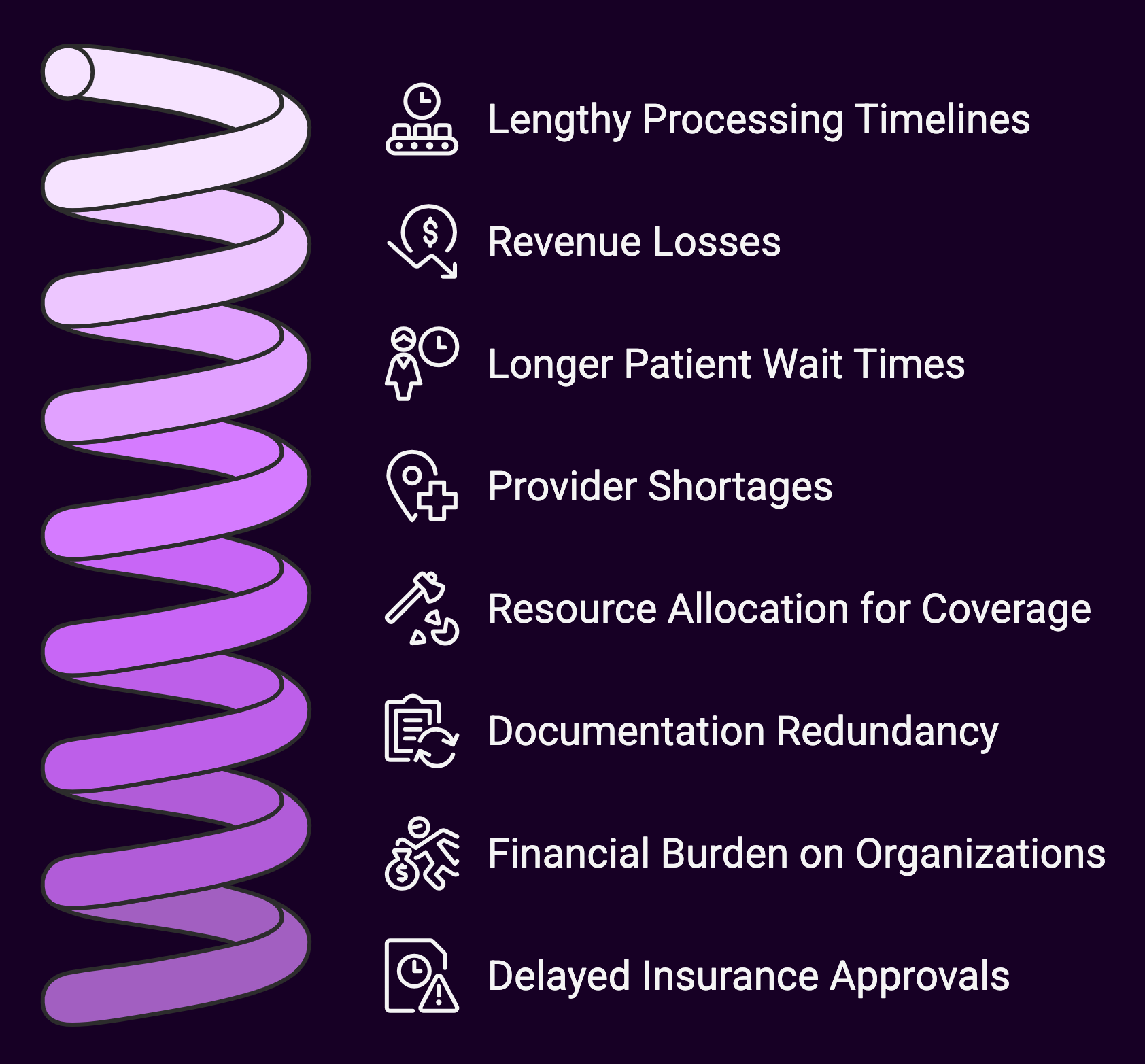Medical credentialing serves as the foundational process that enables qualified healthcare providers to deliver patient care. This systematic verification of qualifications, training, and professional history plays a crucial role in maintaining quality standards and patient safety. However, the credentialing landscape is riddled with significant challenges that impact healthcare delivery at multiple levels. The undermentioned content shows the structural and operational problems within medical credentialing systems and their widespread implications.
The Administrative Burden of Credentialing

Lengthy Processing Timelines
One of the most pressing challenges in medical credentialing is the extensive time required to complete the process. Primary source verification, the practice of confirming credentials directly with issuing institutions, typically takes between 60 and 180 days. This protracted timeline creates substantial delays between when a provider is hired and when they can legally practice or bill for services.
These delays have cascading effects throughout the healthcare system:
- Healthcare organizations face revenue losses while waiting for new providers to become billable
- Patients experience longer wait times for appointments as new providers remain unavailable
- Rural and underserved areas suffer prolonged provider shortages when credentialing delays prevent workforce deployment
- Healthcare systems must allocate resources to temporary coverage solutions during credentialing periods
Documentation Redundancy
The current credentialing ecosystem forces healthcare providers to submit virtually identical information across multiple organizations. Each hospital, healthcare system, insurance panel, and state licensing board maintains its own credentialing requirements and verification processes.
This fragmentation results in:
- Providers submitting the same core documentation dozens of times throughout their careers
- Healthcare administrators managing redundant verification processes for identical credentials
- Increased likelihood of discrepancies between credentialing databases
- Substantial time investment from clinical professionals that reduces patient care availability
Financial Implications
The financial burden of credentialing inefficiencies affects stakeholders throughout healthcare:
- Healthcare organizations typically invest $7,000-$12,000 per provider in credentialing processes
- Large healthcare systems maintain dedicated credentialing departments with substantial personnel costs
- Private practitioners face revenue delays of 2-6 months while awaiting insurance panel approvals
- Recurring credentialing and privileging cycles create ongoing administrative expenses
- Opportunity costs from delayed billing capabilities often reach tens of thousands of dollars per provider
Systemic Challenges in Medical Credentialing
Fragmentation and Lack of Standardization
The medical credentialing landscape lacks cohesion and standardization across jurisdictions and organizations:
- Licensing requirements vary significantly between states, creating barriers to provider mobility
- Each payer maintains unique credentialing standards and verification protocols
- Hospital privileging processes differ even within the same healthcare markets
- Professional certification bodies operate independently with limited coordination
- Verification standards lack uniformity across different types of healthcare facilities
This fragmentation impedes workforce mobility, exacerbates regional provider shortages, and creates unnecessary administrative complexity.
Primary Source Verification Challenges
The gold standard of credential verification (direct confirmation from issuing institutions) presents numerous operational difficulties:
- Educational institutions vary in their responsiveness and verification procedures
- International medical graduates face additional verification hurdles with foreign credentials
- Historic credentials from merged or closed institutions require special handling
- Manual verification processes remain common despite technological advances
- Verification fees and administrative barriers differ among credentialing sources
Credential Maintenance and Expiration Management
Healthcare providers must maintain numerous credentials with varying renewal cycles:
- State licenses typically renew every 1-3 years
- Board certifications have 7-10 year renewal cycles
- DEA registrations require renewal every three years
- Continuing education requirements vary by specialty and jurisdiction
- Professional liability insurance requires annual verification
Tracking these various expiration dates creates substantial administrative burden for both providers and healthcare organizations. The consequences of missed renewals can be severe, including practice interruptions and compliance violations.
Credentialing’s Impact on Healthcare Access and Quality
Delays in Care Availability
Credentialing inefficiencies directly impact patient access to care:
- New healthcare facilities face delays in opening due to provider credentialing timelines
- Service expansions require credentialing approval before implementation
- Temporary coverage for leaves of absence requires expedited credentialing
- Emergency staffing needs conflict with standard credentialing timelines
- Telehealth expansion faces multi-state credentialing barriers
Geographic Disparities
The credentialing process disproportionately affects underserved areas:
- Rural facilities face greater difficulties in expediting credentialing processes
- Provider shortages become more acute when credentialing delays onboarding
- Geographic areas with fewer administrative resources struggle with credentialing efficiency
- Cross-state practice faces additional licensing hurdles in areas near state borders
- Locum tenens providers require rapid credentialing to address short-term needs
Quality Monitoring Challenges
While designed to ensure quality, credentialing systems face challenges in ongoing competency assessment:
- Initial verification provides only a point-in-time assessment of qualifications
- Ongoing monitoring of clinical outcomes varies widely among organizations
- Professional discipline reporting systems lack uniformity across jurisdictions
- Performance issues at one facility may not be visible to other credentialing bodies
- Peer review processes vary significantly in rigor and implementation
Telehealth and the Credentialing Challenge
The rapid expansion of telehealth has highlighted specific credentialing complications:
- Multi-state practice requires providers to maintain licenses across numerous jurisdictions
- Credentialing by proxy arrangements vary in acceptability across organizations
- Virtual care platforms must verify credentials for providers across diverse geographic areas
- State-specific scope of practice rules create telehealth credentialing complexity
- Parity in credentialing between virtual and in-person providers remains inconsistent
Payer Credentialing Complexities
Insurance panels maintain their own credentialing requirements, creating additional challenges:
- Each payer requires separate application and verification processes
- Panel openings and closures affect provider participation opportunities
- Credentialing delays frequently exceed contractual timelines
- Group vs. individual provider credentialing creates administrative complexity
- Delegated credentialing arrangements vary in implementation and effectiveness
Technological Solutions and Their Limitations
Credentialing Software Platforms
Technology offers potential solutions to credentialing inefficiencies:
- Credentialing software can streamline application processes and tracking
- Database integration reduces redundant data entry requirements
- Automated verification systems expedite certain credential confirmations
- Digital document management improves credential maintenance
- Workflow management tools enhance process efficiency
However, technological solutions face implementation barriers:
- Legacy systems often lack integration capabilities
- Data standardization remains incomplete across platforms
- Initial implementation requires significant resource investment
- User adoption varies across healthcare organizations
- Security and privacy concerns affect information sharing capabilities
Credentialing Verification Organizations (CVOs)
Centralized verification entities offer economies of scale but face limitations:
- Delegation agreements require extensive oversight and auditing
- Not all payers accept CVO verification results
- Hospital privileging often remains separate from CVO processes
- Implementation varies widely across healthcare markets
- Cost-benefit analyses differ based on organizational size and credentialing volume
Regulatory and Compliance Factors
Accreditation Requirements
Multiple accreditation bodies influence credentialing practices:
- The Joint Commission maintains specific credentialing standards for hospitals
- NCQA certification applies to managed care organizations
- URAC standards affect utilization review organizations
- AAAHC requirements govern ambulatory care settings
- CMS Conditions of Participation include credentialing elements
These varying standards create compliance complexity for organizations seeking multiple accreditations.
Legal Liability Considerations
Credentialing carries significant legal implications:
- Negligent credentialing claims arise when inadequate verification processes are implemented
- Corporate negligence theories extend liability to organizational oversight failures
- Documentation deficiencies create legal vulnerability even when processes are sound
- State laws vary in their treatment of credentialing evidence in malpractice litigation
- Peer review protections differ across jurisdictions
International Medical Graduates and Credentialing Barriers
Providers educated outside the United States face additional credentialing challenges:
- Verification of international credentials requires specialized processes
- Educational equivalency determinations add complexity and time
- Language proficiency requirements create additional verification needs
- Visa status affects credentialing timeline and requirements
- International training programs vary in recognition across credentialing bodies
Future Challenges and Opportunities
Movement Toward Standardization
Efforts to streamline credentialing face both progress and obstacles:
- Interstate licensure compacts show promise but have incomplete adoption
- Universal provider applications reduce redundancy but remain inconsistently used
- Digital credential wallets offer potential for provider-controlled verification
- Blockchain verification systems provide technological possibilities but face implementation barriers
- Federal standardization efforts compete with state-level regulatory authority
Ongoing Credentialing Reform Needs
Future improvements to medical credentialing will require addressing fundamental issues:
- Balancing thorough verification with operational efficiency
- Creating sustainable funding models for credentialing infrastructure
- Developing more responsive systems for emerging healthcare delivery models
- Implementing real-time credential verification capabilities
- Establishing appropriate metric-based assessment of credentialing outcomes
Summary: Problems in Modern Medical Credentialing
Medical credentialing faces substantial challenges that affect healthcare delivery at multiple levels. While essential for ensuring provider qualifications and patient safety, current credentialing systems often create inefficiencies that delay care, increase costs, and burden healthcare professionals. Addressing these real-world credentialing problems requires coordinated efforts across regulatory bodies, healthcare organizations, technology providers, and policymakers.
The future of medical credentialing likely involves greater standardization, technological integration, and process efficiency without sacrificing verification integrity. Recognizing and systematically addressing these challenges permits healthcare systems to maintain rigorous quality standards while reducing the administrative burden that currently characterizes medical credentialing processes.

